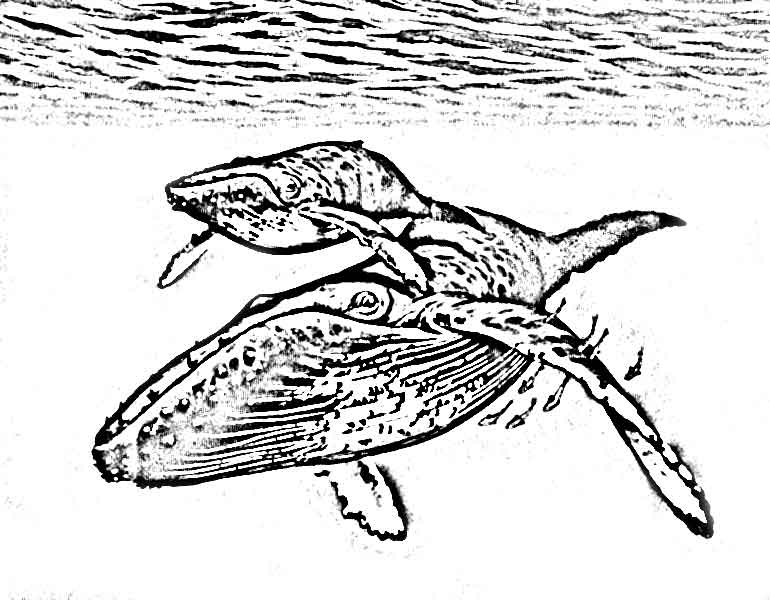Now and then we are happily surprised by whales showing themselves during sailing. It’s a real Caribbean sailing delight!
Text by Mallika. Images by Deep.
Every time it is amazing to see how big they are. Despite their immense weight they fling themselves partly above sea level as if they are an elegant dolphin.
In the Windward Caribbean Islands you can spot the sperm whale, humpback whale and the smaller pilot whale. The biggest change to see them is during the months January till April. They escape the cold winter from the north, where their feeding grounds are, to meet each other in the warm Caribbean waters to mate. Not only humans think this part of the world is just perfect for their honeymoon!
What does baby whale eat?
The mother milk of whales contains a very high fat percentage of minimum 35% and looks like real yoghurt. Because of its thickness the milk won’t break apart in the water and the calf can easily eat it. A blue whale calf drinks as much as 100 gallons (about 400 liter) of milk a day. It may increase its weight by nine pounds an hour. It can grow an inch (25 cm) a day. It can be understand that twins are rare. Simply because mom can’t produce enough milk for two. Suckling may continue anywhere from 6 months to 2 years.
What do adult whales eat?
Food is not only extremely important for the survival of whales, it’s also important for maintaining balance in the oceans ecosystem. Whales help to maintain a stable food chain and ensure that certain animal species do not overpopulate the ocean. A blue whale for example can consume as much as 40 million krill (small shrimps) per day, so you can imagine the impact this would have on the aquatic ecosystem if the blue whale species were to become extinct.
Their diet is dependent on the type of whale: Baleen or toothed.
Baleen whales hunt for food using a technique known as filter feeding in which they swim around with their mouths open and filter food through their baleen bristles. The baleen bristles act like a filter by allowing water to escape while being packed tightly enough to prevent their prey from getting out. Depending on the species, baleen whales may use a number of different hunting methods to capture their prey. One of these methods may include simply swimming towards their prey with their mouth open while capturing their prey in the baleen bristles then pushing the water out with its tongue.
Another method that is used by baleen whales is to have several whales circle around a group or swarm of fish and blows bubbles from around and underneath the fish in order to herd them into a ball and push them towards the surface. Once this is done the whales can take turns swimming through the helpless swarm and pick off the fish one at a time. Baleen whales may choose to hunt for food alone or as a group depending on their species and the pod they belong to.
Toothed whales are active hunters and some are known to eat larger forms of prey than baleen whales. They will eat fish, squid,octopus and various crustaceans while species such as the killer whale will hunt and consume various marine mammals, seabirds and even whales. The orca (killer whale) hunts in groups and are often referred to as the wolves of the sea due to the fact that when they hunt for food they resemble a pack of wolves. Depending on the whales size, social structure, environment, species and type (baleen or toothed) their diets can change drastically from small aquatic life forms such as fish, shrimp, larvae, plankton, crabs, krill and squid to larger marine life.
How do whales find their food?
Whales have different techniques to spot their food, but the most successful technique is known as echolocation.
Echolocation works by emitting a series of clicking and busing noises and then listening to the echo’s that bounce off of objects in the area (such as fish or other aquatic life forms). The amount of time it takes the echo to return to the whale can provide these marine mammals vital information such as how far the object is, how dense it is (hard or soft), and whether or not the object is moving or still. By using echolocation whales are able to determine whether the object is prey, a predator or an inanimate object. Whales will continue to create these sounds until they find the prey they are looking for and then decide the best method for hunting and attacking their prey.
Echolocation is also useful for navigating the ocean in dark environments as the echoes help to create a map that can help the whale determine where various objects are so that it can avoid collision with them.
In fact echolocation is a highly developed technique that is of great importance to these big mammals. It makes the use of their eyes less important.
In the next article you can read about Whales, and their importance to the world
You will receive this article automatically if you subscribe to our NEWSLETTER
**BOOK NOW** your holiday with SY Yemaya and experience the beautiful windward islands yourself!
Sources:
- article from magazine Compass April 2014 no. 223, written by Nathalie Ward.
Websites:
- http://www.whalefacts.org
- http://scienceline.ucsb.edu/getkey.php?key=1009
- http://www.scientificamerican.com/article/how-do-whales-and-dolphin


